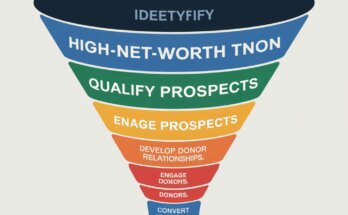In the world of nonprofits, donor stewardship is a crucial aspect of building lasting relationships with supporters. It’s not just about thanking donors; it’s about engaging them in your mission and making them feel valued.
The best practices for donor stewardship can transform your organization’s funding landscape, encouraging ongoing support and deepening connections.
Understanding Donor Stewardship
Donor stewardship goes beyond the initial gift. It’s about nurturing the relationship you have with your supporters over time. When donors feel appreciated and informed, they are more likely to continue their support and even increase their contributions.
This is where the best practices for donor stewardship come into play, allowing nonprofits to cultivate a loyal donor base.
Why Donor Stewardship Matters
Effective donor stewardship can significantly impact your organization’s success.
It fosters trust, increases donor retention rates, and can lead to larger gifts over time.
A well-stewarded donor is not just a financial supporter; they become an advocate for your cause, spreading the word and encouraging others to get involved.
Best Practices for Donor Stewardship
Let’s delve into some best practices for donor stewardship that can help your nonprofit shine in the eyes of your supporters.
1. Personalized Thank-You Messages
A heartfelt, personalized thank-you message is one of the simplest yet most effective ways to show appreciation. Rather than sending a generic email, take the time to acknowledge each donor by name and reference their specific gift. This shows that you recognize their contribution and value their support.
Example: If a donor gives to a specific project, mention that project in your thank-you note. “Thank you, [Donor’s Name], for your generous support of our literacy program! Your contribution will help us provide books to children in need.”
2. Regular Communication
Keeping your donors informed is vital for maintaining their interest and investment in your mission. Regular updates about your organization’s activities, successes, and challenges help donors feel connected to your work.
Example: Consider sending out monthly newsletters that highlight your achievements, share stories of impact, and outline upcoming events. Don’t forget to include donor spotlights to showcase the individuals who make your work possible.
3. Involve Donors in Your Mission
Invite donors to be a part of your organization beyond their financial contributions. Engaging them in volunteer opportunities or events can deepen their connection to your cause.
Example: Host an annual donor appreciation event where supporters can meet your team, learn about the impact of their donations, and see your programs in action. This not only strengthens relationships but also allows donors to see firsthand how their support is making a difference.
4. Share Impact Stories
Storytelling is a powerful tool in nonprofit communication. Sharing real stories about the lives you’ve changed through donor support can create emotional connections and demonstrate the tangible impact of contributions.
Story Example: Consider Sarah, a single mother who struggled to provide for her children after losing her job. With support from your organization’s job training program, she not only found stable employment but also gained the skills to advance her career. By sharing her story in newsletters and social media posts, you highlight how donor contributions directly change lives, making supporters feel proud to be part of that journey.
5. Recognize Donor Milestones
Acknowledge important milestones in your donor’s journey. Whether it’s their anniversary of giving or reaching a certain donation level, celebrating these moments can enhance their connection to your organization.
Example: Send a special note to donors who have given for five consecutive years, thanking them for their loyalty and commitment. Consider providing a small token of appreciation, like a custom pin or a feature in your newsletter, to honor their support.
6. Utilize Social Media for Engagement
Social media platforms provide an excellent opportunity to engage with donors in real-time. Share updates, stories, and thank-yous publicly to show your appreciation and keep your community informed.
Example: Use platforms like Facebook or Instagram to highlight donor contributions with posts that tag and thank them publicly. “A big shoutout to [Donor’s Name] for their generous support of our upcoming community event! We couldn’t do it without you!”
7. Create Donor Engagement Opportunities
Organizing events that encourage interaction among donors, staff, and beneficiaries can create a sense of community and belonging.
Example: Consider hosting a community forum or town hall meeting where donors can ask questions, provide feedback, and share ideas. This involvement makes them feel valued and heard, fostering a deeper connection to your mission.
8. Send Impact Reports
Transparency builds trust. Regularly share impact reports that detail how donor funds are used, what successes have been achieved, and what challenges lie ahead.
Example: Create an annual report that outlines your organization’s financials, program outcomes, and future goals. Send this report to all donors to give them a clear picture of their impact and the ongoing need for their support.
9. Solicit Feedback from Donors
Asking for donor feedback shows that you value their opinion and are committed to improving your organization. This practice can provide valuable insights into donor preferences and experiences.
Example: After an event, send out a brief survey to attendees asking for their thoughts on the event, what they enjoyed, and how it could be improved. Use their responses to enhance future donor interactions.
10. Provide Opportunities for Recurring Giving
Encouraging recurring donations can help stabilize your funding and foster a deeper commitment from donors.
Example: Offer a monthly giving program that allows donors to set up automatic contributions. Highlight the impact of monthly giving in your communications, showing how consistent support can lead to significant changes over time.
Conclusion: Cultivating Stronger Relationships
Implementing these best practices for donor stewardship can significantly enhance your organization’s relationships with supporters. By prioritizing personalized communication, engaging storytelling, and transparency, nonprofits can foster loyalty and long-term support.
Don’t forget to take advantage of additional resources to improve your donor stewardship practices. Download our – Top 10 Donor Stewardship Strategies for Nonprofits + Free Donor Engagement Checklist – to help you implement these strategies effectively.
For more expert tips and resources on nonprofit management, be sure to subscribe to the “Nonprofit Navigators Newsletter.“ Stay informed, inspired, and equipped to take your donor stewardship efforts to the next level!
Additional Resources:
- Digital Marketing for Nonprofits: A Comprehensive Guide to Boosting Your Impact Online
- Mastering Online Fundraising: A Nonprofit’s Guide to Digital Success
“Hi, I’m Queen Israel Nweke! I help nonprofits thrive by mastering grant writing, strategic funding, and effective nonprofit management, enabling them to secure resources and make a lasting impact in their communities.
Interested in any of these services? Contact me at nonprofitnavigatorsconsult@gmail.com.”




